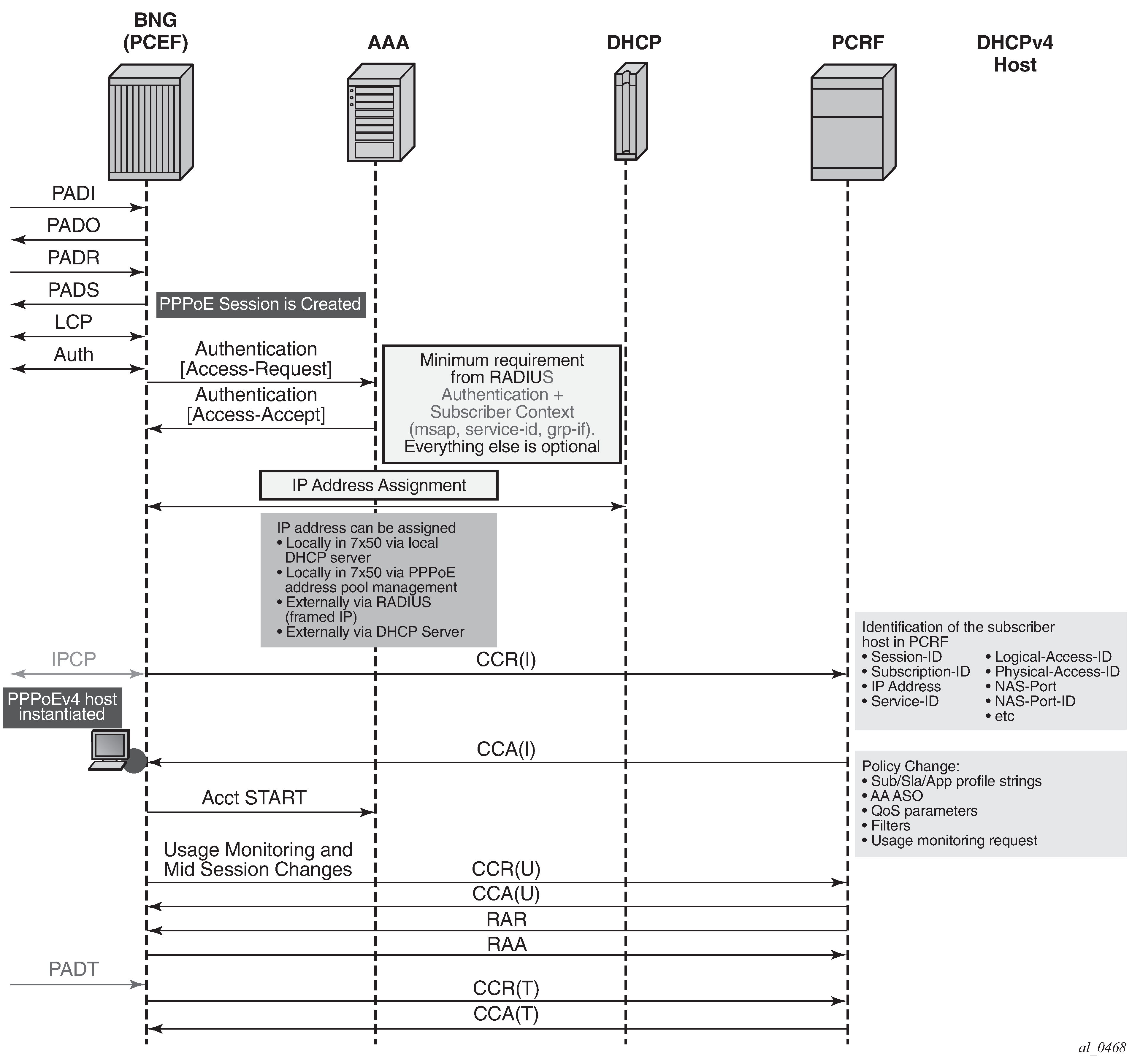Policy management via Gx enables operators to consolidate policy management systems used in wireline (mostly based on RADIUS/CoA) and wireless environment (PCRF/Gx) into a single system (PCRF/Gx).
The model for policy instantiation/modification via Gx is similar to the one using RADIUS CoA. The authentication and IP address assignment is provided outside of Gx while the policy management function is provided via Gx.
Some PCRFs may require that the IP address information is passed from the node in CCR-I. This assumes that the IP address assignment phase (via LUDB, RADIUS or DHCP Server) is completed before the PCRF is contacted via CCR-I. Message flow for various protocols (DHCP, AAA, Gx) related to IPv4 subscriber-host instantiation phase is shown in Figure: Message slow during DHCPv4 host instantiation phase.
CCR-I message is sent to the PCRF after DHCP Ack is received from the DHCP server. Relaying DHCP Ack to the client in the final phase of the host instantiation process depends on the answer from the PCRF and the configuration settings of the fallback function if the answer is not received.
This model allows the IP address of the host to be sent in the CCR-I message, even though the subscriber-host is not fully instantiated at the time when the CCR-I message is generated.
AAA/LUDB must still be used for authentication and assignment of parameters necessary to place the subscriber host in the correct routing context (service-id, grp-id, msap-policy).
The start of the accounting process fits into this model because the host is not instantiated until the policy information from all sources (Gx, AAA, defaults) is known. After the final sub-profile (containing the acct-policy) is known, the host is instantiated and accounting can consequently be activated.
If the IP address cannot be assigned via Gx, and this functionality is outside of the Gx scope (3GPP TS 23.203 Rel12, Annex S, IP-CAN Session Establishment section).
The purpose of the CCR-I message is the following:
To notify the PCRF that the sub-host was about to be instantiated on the node. Consequently, the PCRF creates a Gx session for the subscriber host if the CCR-I is successfully processed by PCRF.
To identify the subscriber host in the PCRF, the PCRF uses the subscriber host identification information to identify the policy (for the subscriber host) that needs to be submitted to the node. The policy rules can be sent via CCA-i immediately following the initial CCR-I or they can be modified at any time during the subscriber-host lifetime through RAR messages.
Figure: Message slow during DHCPv4 host instantiation phase shows the message flow during the DHCPv4 host instantiation phase.

Message flow for PPPoEv4 host is similar. The host is instantiated after the answer from PCRF is received.
However, IPCP negotiation and Gx negotiation (CCR/CCA) are performed in parallel, independently of each other, and therefore the node does not wait for the Gx session to be established before the last IPCP ConfAck is sent (as it is for DHCP ACK).
After the host is instantiated on the node (after the CCA-i is received or as defined by the fallback action if the PCRF is not available), the Accounting-Start message is sent by the node (assuming that accounting is enabled).
The message flow is shown in Figure: Message flow during PPPoEv4 host instantiation phase.

The host is created when the Gx session is established and therefore the subscriber host transitions into the traffic forwarding state when the Gx processing is completed. If the PCRF is unavailable or unresponsive, the host creation or termination is driven by the fallback configuration.